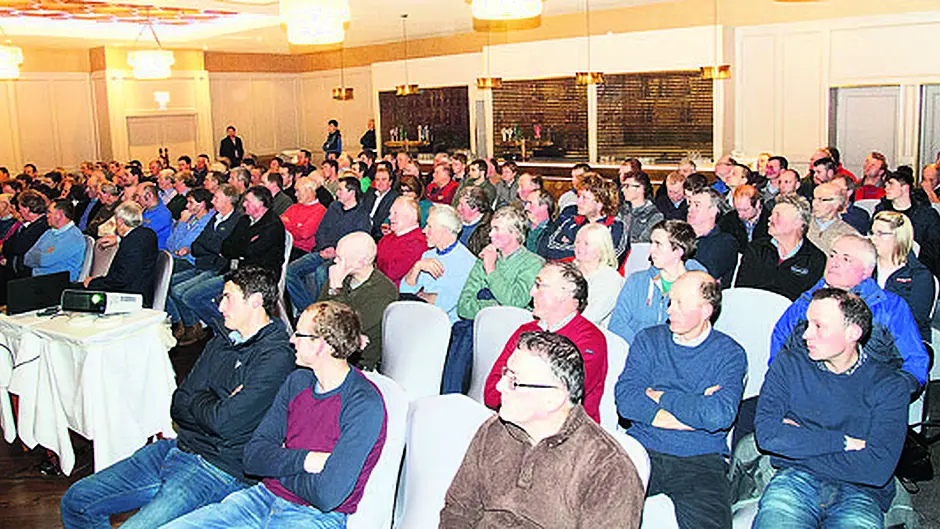Over 200 people were in attendance at the Lisavaird Co-Op annual seminar in the Inchydoney Lodge & Spa, Clonakilty, where they heard speakers address topics fundamental to the food and, more specifically, the dairy industry in We
OVER 200 people were in attendance at the Lisavaird Co-Op annual seminar in the Inchydoney Lodge & Spa, Clonakilty, where they heard speakers address topics fundamental to the food and, more specifically, the dairy industry in West Cork
Professor Finbar Mulligan from the UCD School of Veterinary Medicine presented results from two years of trials being carried on in the UCD farm at Lyons Estate. These trials are attempting to measure the economics and feasibility of a high-output, grass-based, Spring milk production system.
This is a first, not just in Irish terms, but globally. There has been a lot of research, much of it in Ireland, into low-input and low-output systems. but this is a first for Prof Mulligan and his team. Research into a high-output dairy system is of great interest to many farmers in West Cork due to the limited availability of land around the milking platform. It is also of interest to farmers who may wish to increase output in a sustainable manner without the need for extra stock, land, facilities or labour.
From a national prospective, there is interest in the project in that output can be increased without increasing animal numbers. With the finger being pointed at agriculture as a major greenhouse gas emitter, this may be important in the future.
In an area like West Cork, where many dairy farmers are in derogation from a nitrates point of view, animal numbers and stocking rates will become increasingly important as we enter the next round of CAP negotiations.
Prof Mulligan emphasised that grass is still the cornerstone of the system along with a high output of solids per acre and good fertility. Fertility has been an issue in the system and particular focus will be placed on this as the project continues. The chief executive of Bord Bia, Clonakilty woman Tara McCarthy, presented Bord Bia’s strategy for marketing Irish dairy products worldwide. She pointed out that Irish food and drink exports had grown by 13% in 2017 to €12.6 billion and dairy exports had grown by 19% to €4.0 billion. While this increase in dairy was led by an impressive increase of 44% in exports to Europe the UK is still critical, taking 24% of our butter and half of our cheese exports.
With large food organisations increasingly putting sustainability at the top of their agenda Ms McCarthy pointed to Ireland’s superb credentials in that area in terms of clean water availability, excellent air quality and the low-carbon footprint in our dairy industry. She said we are seen as green and natural by international consumers, but now we need to prove it!
This is why Origin Green, which gathers data from across the entire food chain, was launched. We are the only country in the world doing this on a national basis, she said.
The Sustainable Dairy Assurance Scheme is a critical part of this programme and 96% of the 18,000 dairy farmers in the country are currently signed up for it. Ms McCarthy emphasised that this is critical to the success of marketing our dairy products internationally.
Jason Hawkins was the final speaker on the night – his first time addressing a gathering of West Cork dairy farmers since his appointment as CEO of Carbery Group in the first of January. He opened with his perspective on the company since his arrival from the US, speaking of its history of success, its focus on returning a leading milk price to farmers, its deep connection with the West Cork community and its ambitions for the future.
He then addressed the outlook for dairy markets in 2018 concentrating on the global supply and demand for milk products. In general, global supply is growing at about 1.5% while demand is growing at a somewhat similar pace.
However, regional and seasonal factors can affect this, such as the current surge in European supplies and the current downturn in New Zealand growth due to drought. Demand similarly can be affected for a period by factors such as the strength of the global economy, oil prices, exchange rates, etc.
Mr Hawkins gave the audience a thorough briefing on the issues affecting the upside and downside potential for each of the important dairy product categories for the next 12 months. After a period of sustained falls in the latter half of 2017, the market has stabilised somewhat since Christmas and much will depend on what transpires over the next six weeks.









